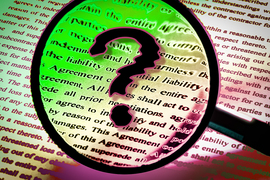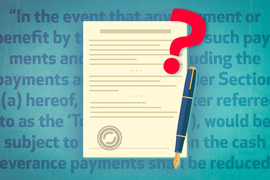Legal documents are notoriously difficult to understand, even for lawyers. This raises the question: Why are these documents written in a style that makes them so impenetrable?
MIT cognitive scientists believe they have uncovered the answer to that question. Just as “magic spells” use special rhymes and archaic terms to signal their power, the convoluted language of legalese acts to convey a sense of authority, they conclude.
In a study appearing this week in the journal of the Proceedings of the National Academy of Sciences, the researchers found that even non-lawyers use this type of language when asked to write laws.
“People seem to understand that there’s an implicit rule that this is how laws should sound, and they write them that way,” says Edward Gibson, an MIT professor of brain and cognitive sciences and the senior author of the study.
Eric Martinez PhD ’24 is the lead author of the study. Francis Mollica, a lecturer at the University of Melbourne, is also an author of the paper.
Casting a legal spell
Gibson’s research group has been studying the unique characteristics of legalese since 2020, when Martinez came to MIT after earning a law degree from Harvard Law School. In a 2022 study, Gibson, Martinez, and Mollica analyzed legal contracts totaling about 3.5 million words, comparing them with other types of writing, including movie scripts, newspaper articles, and academic papers.
That analysis revealed that legal documents frequently have long definitions inserted in the middle of sentences — a feature known as “center-embedding.” Linguists have previously found that this kind of structure can make text much more difficult to understand.
“Legalese somehow has developed this tendency to put structures inside other structures, in a way which is not typical of human languages,” Gibson says.
In a follow-up study published in 2023, the researchers found that legalese also makes documents more difficult for lawyers to understand. Lawyers tended to prefer plain English versions of documents, and they rated those versions to be just as enforceable as traditional legal documents.
“Lawyers also find legalese to be unwieldy and complicated,” Gibson says. “Lawyers don’t like it, laypeople don’t like it, so the point of this current paper was to try and figure out why they write documents this way.”
The researchers had a couple of hypotheses for why legalese is so prevalent. One was the “copy and edit hypothesis,” which suggests that legal documents begin with a simple premise, and then additional information and definitions are inserted into already existing sentences, creating complex center-embedded clauses.
“We thought it was plausible that what happens is you start with an initial draft that’s simple, and then later you think of all these other conditions that you want to include. And the idea is that once you’ve started, it’s much easier to center-embed that into the existing provision,” says Martinez, who is now a fellow and instructor at the University of Chicago Law School.
However, the findings ended up pointing toward a different hypothesis, the so-called “magic spell hypothesis.” Just as magic spells are written with a distinctive style that sets them apart from everyday language, the convoluted style of legal language appears to signal a special kind of authority, the researchers say.
“In English culture, if you want to write something that’s a magic spell, people know that the way to do that is you put a lot of old-fashioned rhymes in there. We think maybe center-embedding is signaling legalese in the same way,” Gibson says.
In this study, the researchers asked about 200 non-lawyers (native speakers of English living in the United States, who were recruited through a crowdsourcing site called Prolific), to write two types of texts. In the first task, people were told to write laws prohibiting crimes such as drunk driving, burglary, arson, and drug trafficking. In the second task, they were asked to write stories about those crimes.
To test the copy and edit hypothesis, half of the participants were asked to add additional information after they wrote their initial law or story. The researchers found that all of the subjects wrote laws with center-embedded clauses, regardless of whether they wrote the law all at once or were told to write a draft and then add to it later. And, when they wrote stories related to those laws, they wrote in much plainer English, regardless of whether they had to add information later.
“When writing laws, they did a lot of center-embedding regardless of whether or not they had to edit it or write it from scratch. And in that narrative text, they did not use center-embedding in either case,” Martinez says.
In another set of experiments, about 80 participants were asked to write laws, as well as descriptions that would explain those laws to visitors from another country. In these experiments, participants again used center-embedding for their laws, but not for the descriptions of those laws.
The origins of legalese
Gibson’s lab is now investigating the origins of center-embedding in legal documents. Early American laws were based on British law, so the researchers plan to analyze British laws to see if they feature the same kind of grammatical construction. And going back much farther, they plan to analyze whether center-embedding is found in the Hammurabi Code, the earliest known set of laws, which dates to around 1750 BC.
“There may be just a stylistic way of writing from back then, and if it was seen as successful, people would use that style in other languages,” Gibson says. “I would guess that it’s an accidental property of how the laws were written the first time, but we don’t know that yet.”
The researchers hope that their work, which has identified specific aspects of legal language that make it more difficult to understand, will motivate lawmakers to try to make laws more comprehensible. Efforts to write legal documents in plainer language date to at least the 1970s, when President Richard Nixon declared that federal regulations should be written in “layman’s terms.” However, legal language has changed very little since that time.
“We have learned only very recently what it is that makes legal language so complicated, and therefore I am optimistic about being able to change it,” Gibson says.









